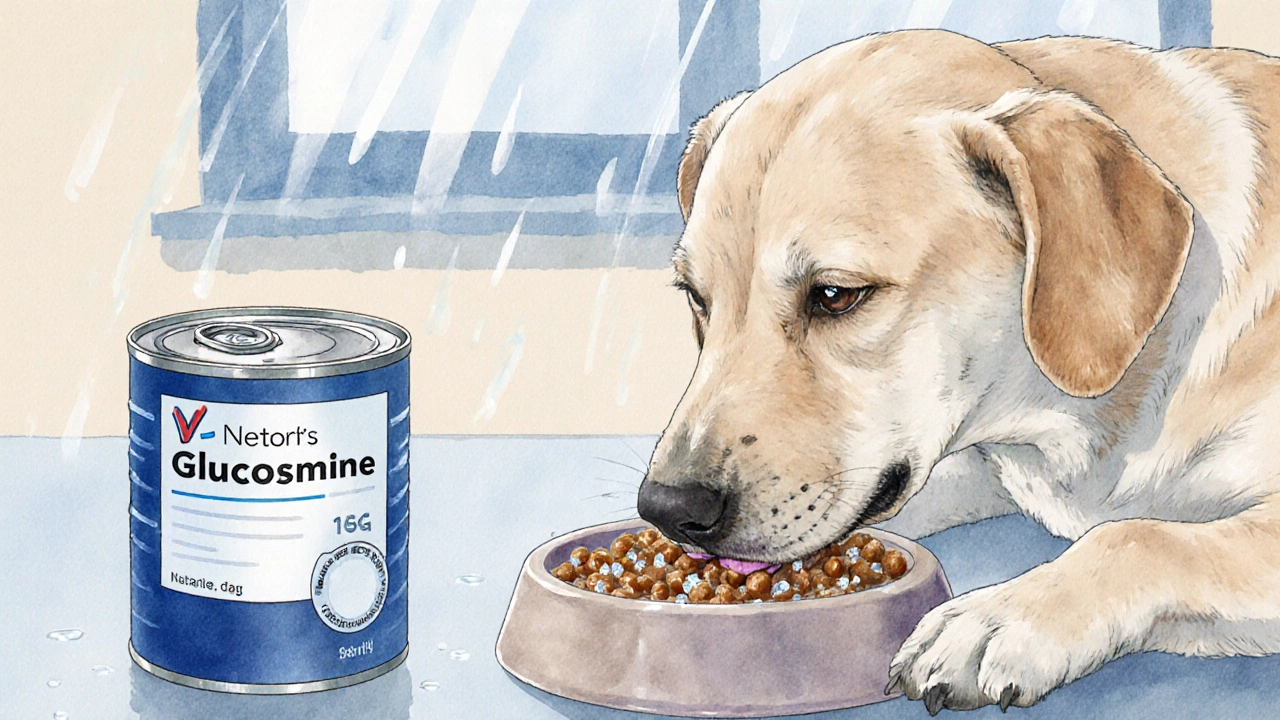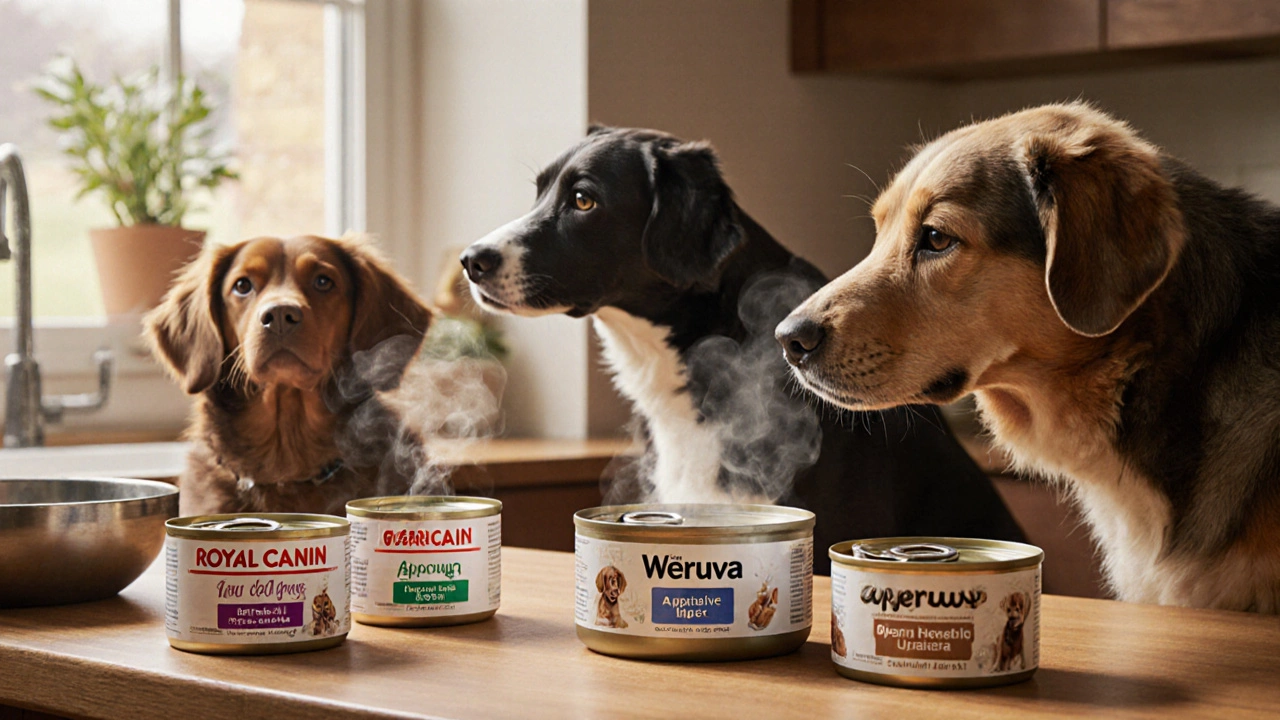Dog Wet Food Portion Calculator
If you’ve ever stared at the dog food aisle wondering which wet food is actually good for your dog, you’re not alone. With dozens of brands, textures, and ingredient lists, it’s easy to feel overwhelmed. But the truth is, not all wet dog food is created equal-and the right choice can make a big difference in your dog’s energy, digestion, and even coat shine.
Why Wet Food Matters for Dogs
Wet food isn’t just a treat or a backup option. For many dogs, it’s a daily necessity. Dogs with dental issues, older dogs, or those who don’t drink enough water often thrive on wet food. The high moisture content-usually 70% or more-helps keep them hydrated, which supports kidney and urinary tract health. That’s especially important if your dog is on dry food most of the time, which only contains about 10% water.Wet food also tends to be more palatable. If your dog turns up their nose at kibble, a rich-smelling can of wet food might be the key to getting them to eat. And for picky eaters or dogs recovering from illness, that extra flavor and texture can be a lifesaver.
What Makes Wet Food ‘Good’?
Not every can labeled ‘premium’ is actually good. Here’s what to look for:- Real meat as the first ingredient-Look for chicken, beef, lamb, or fish listed first. Avoid vague terms like ‘meat by-products’ or ‘animal digest’.
- No artificial additives-Skip colors, flavors, or preservatives like BHA, BHT, or ethoxyquin. These serve no nutritional purpose and can cause long-term issues.
- AAFCO statement-The label must say the food is ‘complete and balanced’ for your dog’s life stage (adult, puppy, senior). This isn’t marketing-it’s a legal standard.
- Low carbohydrate content-Many wet foods use grains or starchy fillers like corn or potato. Dogs don’t need high carbs. Look for options with fewer than 10% carbohydrates on a dry matter basis.
- High protein-Aim for at least 8-12% crude protein in the wet food (on an as-fed basis). That’s typically 30-40% on a dry matter basis.
For example, a good wet food might list ‘chicken’ as the first ingredient, followed by chicken broth, liver, and carrots. No peas, no rice, no soy. That’s a clean, simple formula your dog’s body was built to process.
Best Wet Food Brands for Dogs in 2025
Based on ingredient quality, vet feedback, and owner reports from UK dog owners, these brands consistently deliver:- Royal Canin Veterinary Diet-Formulated for specific health needs like kidney support, sensitive stomachs, or weight management. Often recommended by vets.
- Now Fresh Grain-Free-Uses real meat, no grains, no artificial preservatives. Popular with owners who want a clean, simple option.
- Weruva-Made in the USA with human-grade ingredients. Their ‘B.A.R.F.’ line is especially popular for raw-style nutrition.
- Stella & Chewy’s-Freeze-dried raw patties you rehydrate. Great for dogs who need high protein and low carbs.
- Applaws-A UK-based brand with high meat content and minimal ingredients. Often found in pet stores like Pets at Home.
These brands don’t rely on fillers. They don’t hide behind ‘meat meals’ or ‘poultry by-product’. They use whole ingredients-and that matters.

Wet Food for Puppies and Senior Dogs
Puppies need more calories and fat for growth. Look for wet food labeled ‘for growth’ or ‘for all life stages’. Brands like Royal Canin Puppy and Blue Buffalo Life Protection Puppy offer formulas with DHA for brain development and calcium for strong bones.Senior dogs often need lower phosphorus and sodium, plus joint support. Hill’s Science Diet Senior and Wellness Core Senior include glucosamine and chondroitin, and are easier to digest. Their softer texture also helps dogs with worn-down teeth.
Don’t assume adult formulas work for seniors. Their metabolism slows, and their kidneys can’t handle the same load. Always match the food to the life stage.
How Much Wet Food Should You Feed?
There’s no one-size-fits-all answer. Most cans say ‘feed 1 can per 10-15 lbs of body weight daily’-but that’s just a starting point.Check the calorie count per can. Most wet foods range from 250 to 400 kcal per 13-oz can. If your dog is a 50-lb active adult, they need about 900-1,100 kcal per day. That means two to three cans, depending on the brand.
Here’s a simple rule: if your dog is losing weight, increase the amount. If they’re gaining weight, cut back. Always adjust based on their body condition-not the label.
Also, don’t forget to reduce dry food if you’re mixing wet and dry. A half-cup of kibble plus one can of wet food might be too much for a small dog. Balance the total calories.
Common Mistakes to Avoid
Many owners make these errors:- Using wet food only as a topper-If you’re just spooning a tablespoon on top of kibble, you’re not getting the benefits. Wet food should make up at least 50% of their daily intake for maximum hydration and digestibility.
- Choosing based on price alone-The cheapest cans often have the lowest meat content and highest fillers. You get what you pay for.
- Switching brands too often-Dogs’ stomachs are sensitive. If you’re switching every week, you’ll cause diarrhea or vomiting. Change gradually over 5-7 days.
- Ignoring the expiration date-Wet food can spoil. Always check the ‘best before’ date and store opened cans in the fridge for no more than 3 days.

When to Avoid Wet Food
Wet food isn’t always the answer. Avoid it if:- Your dog has severe dental disease and can’t chew even soft food-then consider a soft kibble or prescription diet.
- You’re on a tight budget and can’t afford higher-quality brands-some dry foods are still nutritionally complete and more cost-effective.
- Your dog is prone to obesity-wet food is often higher in calories per gram. You’ll need to measure carefully.
Also, don’t use wet food as a long-term solution if your dog refuses to eat anything else. That could signal an underlying health issue. If your dog suddenly loses interest in food, see your vet.
How to Store and Serve Wet Food
Opened cans go in the fridge. Cover with a lid or plastic wrap. Use within 3 days. Never leave wet food out for more than 2 hours-especially in warm weather. Bacteria grow fast.Warm it slightly before serving. Cold food from the fridge can turn off even the hungriest dog. Run the can under warm water for 30 seconds or microwave it for 10 seconds (stir well first).
Always wash the bowl after each meal. Leftover food sticks and breeds bacteria. A clean bowl is a healthy bowl.
Final Thoughts: What’s the Best Wet Food?
There’s no single ‘best’ wet food for every dog. But the best one for your dog is the one that:- Has real meat as the first ingredient
- Has no artificial junk
- Matches your dog’s age and health needs
- Your dog loves and eats consistently
- Doesn’t cause loose stools or gas
Start with one of the trusted brands listed above. Try a single can. See how your dog reacts over the next week. If their coat looks shinier, their energy improves, and their poop is firm-you’ve found a winner.
Don’t overthink it. Just focus on quality ingredients, proper nutrition, and your dog’s response. That’s all you really need.
Is wet food better than dry food for dogs?
It depends. Wet food is better for hydration, picky eaters, older dogs, and those with dental issues. Dry food is more convenient, cheaper, and can help with mild tartar control. Many owners mix both. The key is matching the food to your dog’s needs-not following trends.
Can I feed my dog wet food every day?
Yes, absolutely. Many dogs thrive on 100% wet food. As long as it’s labeled ‘complete and balanced’ for their life stage, it’s perfectly safe. Just make sure you’re feeding the right amount to avoid weight gain.
What’s the cheapest good wet food for dogs?
Brands like Canidae All Life Stages and Open Farm offer quality ingredients at mid-range prices. Avoid the cheapest store brands-they often use low-quality fillers. A $1.50 can that’s 60% filler isn’t cheaper than a $3 can that’s 90% meat.
Why does my dog only eat wet food and ignore kibble?
It’s usually because wet food tastes better and smells stronger. That’s normal. But if your dog suddenly stopped eating dry food, it could signal a dental problem, nausea, or illness. If this is new behavior, check with your vet.
How do I know if my dog is getting enough nutrition from wet food?
Look at their body condition: ribs should be easy to feel but not visible. Coat should be shiny, not dull. Stools should be firm and well-formed. Energy levels should be steady. If all of that’s good, they’re getting what they need. If not, talk to your vet about switching formulas.



